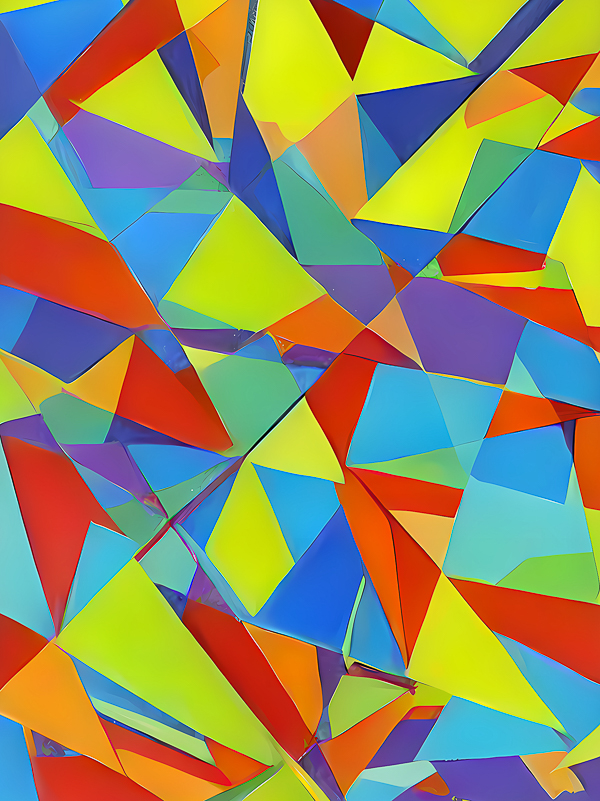Geometric Abstraction art
What is Geometric Abstraction art?
Geometric Abstraction, an intriguing facet of the vast landscape of abstract art, blossomed in the early 20th century with a distinctive emphasis on geometric shapes and ordered compositions. Rooted in precision and systematic design, Geometric Abstraction employs a language of form that resonates with various abstract art principles:
- Basic Geometric Shapes:
Within the realm of abstract art, Geometric Abstraction stands out for its utilization of fundamental geometric shapes—lines, circles, squares, and rectangles—as the elemental components of artistic expression. - Precision and Order:
Geometric Abstraction, in its exploration of abstract art, places a premium on precision and order. Artists meticulously arrange shapes, often employing mathematical principles, to create compositions that exude balance and harmony. - Color Harmony in Abstraction:
The application of color within Geometric Abstraction aligns with the principles of abstract art. Artists exercise control and intentionality, using color to enhance the overall sense of order, structure, and visual impact in their compositions. - Flat Surfaces in Abstract Art:
A distinctive feature in the abstract art language of Geometric Abstraction is the preference for flat surfaces. The emphasis lies on a two-dimensional presentation, where the arrangement of geometric forms becomes the focal point within the picture plane. - Non-representational Elements:
In keeping with abstract art principles, Geometric Abstraction deliberately avoids representational or figurative elements. The focus shifts to non-representational forms, allowing the geometric shapes themselves to convey meaning and aesthetic significance. - Grids and Patterns in Abstraction:
The incorporation of grids and patterns in Geometric Abstraction aligns with abstract art sensibilities. Artists utilize grids to structure their compositions, introducing a sense of order and regularity that resonates within the abstract art landscape. - Mathematical Inspiration in Abstraction:
Geometric Abstraction draws inspiration from mathematical concepts, enriching the abstract art vocabulary with precision and logic. The geometric forms become a visual language, influenced by mathematical principles, contributing to the broader abstract art discourse. - Affinities with Minimalism:
Geometric Abstraction shares affinities with Minimalism, a later movement within abstract art. Both emphasize simplicity, reduction of form, and a focus on essential elements, contributing to the ongoing evolution of abstract art language.
Pioneering artists in Geometric Abstraction, such as Kazimir Malevich and Piet Mondrian, played pivotal roles in shaping the trajectory of abstract art. Their exploration of form, color, and spatial relationships within a geometric framework continues to be a source of inspiration within the diverse tapestry of abstract art.
How to create Geometric Abstraction art?
Creating Geometric Abstraction art involves a thoughtful exploration of geometric shapes, precise arrangements, and a commitment to conveying meaning through structured compositions. Here’s a guide to help you embark on creating your own Geometric Abstraction artwork:
Materials You’ll Need:
1. Surface: Choose a canvas, board, or paper as your painting surface.
2. Paints: Acrylics or oils are commonly used in Geometric Abstraction. Select a color palette that aligns with your artistic vision.
3. Brushes: Have a variety of brushes, including fine detail brushes for precise work.
4. Ruler and Drawing Tools: Ensure straight edges and precise measurements with a ruler or straight edge. Compasses or stencils can also be helpful for creating perfect circles or other shapes.
5. Masking Tape: Use masking tape to create clean, straight lines and defined edges.
6. Palette: Set up a palette for mixing and organizing your colors.
7. Pencil: Sketching and planning can be done in pencil before committing to paint.
Steps to Create Geometric Abstraction:
- Plan Your Composition:
Consider the overall design of your artwork. Plan the arrangement of geometric shapes, lines, and any patterns you want to incorporate. Sketch your ideas on paper before starting on the canvas. - Select a Color Palette:
Choose a color palette that suits your artistic vision. Geometric Abstraction often involves a controlled and harmonious use of color. Consider the emotional impact of different colors and their interactions. - Prepare Your Surface:
Prime your canvas or surface if needed. If you prefer a specific background color, apply it and let it dry before starting your geometric composition. - Create a Grid or Framework:
Use a ruler to create a grid or framework on your canvas. This will serve as the structural foundation for your geometric shapes. Ensure straight lines and precise angles. - Define Geometric Shapes:
Start defining your geometric shapes within the grid. Common shapes include squares, rectangles, circles, triangles, and polygons. Use your ruler and drawing tools to maintain precision. - Use Masking Tape for Clean Lines:
Masking tape can be used to create clean and straight lines. Apply tape along the edges of shapes to maintain sharp lines and prevent colors from bleeding into each other. Remember to remove the tape carefully once the paint is dry. - Experiment with Patterns:
Geometric Abstraction allows for the exploration of patterns within shapes. Consider repetitive patterns, gradients, or variations in color within each geometric element. - Apply Colors:
Begin applying colors to your geometric shapes. Maintain consistency within your chosen color palette. Experiment with the arrangement of colors to achieve the desired visual impact. - Balance and Harmony:
Strive for balance and harmony within your composition. Consider the visual weight of each shape and the overall distribution of colors to create a cohesive and aesthetically pleasing result. - Fine-Tune and Refine:
Step back periodically to assess your artwork. Fine-tune the details, refine edges, and make adjustments as needed. Geometric Abstraction benefits from a meticulous approach to ensure precision. - Allow for Drying Time:
Allow your artwork to dry completely before making any further adjustments or applying additional layers. This is especially important when working with masking tape. - Sign Your Work:
Once your Geometric Abstraction piece is complete, sign your work. Consider a discreet yet intentional placement for your signature within the composition.
Remember that Geometric Abstraction invites exploration and experimentation within the framework of geometric forms. Embrace the precision, order, and visual language of shapes to convey your artistic vision within this fascinating realm of abstract art.



